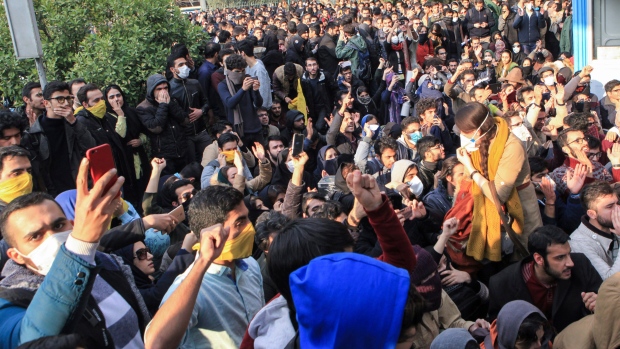We publish here, as an insert, a fragment from Murtaza Hussain’s article on the Iranian protests, which can be read in full at theintercept.com.
Over the past week, tens of thousands of people in dozens of cities across Iran have braved bullets and tear gas in a public outpouring of dissent against the country’s ruling establishment. Videos of demonstrations shared on social media have shown protesters smashing government-owned banks, tearing down posters of government officials, and at times calling for the end of clerical rule in the country. At least 22 people are reported to have been killed since the unrest began December 28, with human rights groups saying hundreds more were detained by security forces.
The outbreak and nature of the unrest have taken many analysts of Iranian politics by surprise. Rather than emerging from liberal Tehran, these protests appear to have originated in working-class conservative cities and towns that the Islamic Republic likes to depict as its core constituency. One group of people, however, has long expected such an outbreak of discontent from the economically disadvantaged people in these areas: Iranian labor activists.
“Working people in Iran have been dreaming of a better life for four decades, but today ordinary people often have to work two or three jobs simply to survive,” says Mehdi Kouhestaninejad, a longtime Iranian trade unionist now living in Canada, who is active in the international solidarity movement for workers’ rights in Iran. “Many people inside and outside Iran may be shocked by what is going on, but trade unionists have been warning for the past 10 years that there will be an uprising against the ruling class and their kleptocracy.”

Unlike the 2009 Green Movement, which was largely a product of the educated, urban Tehrani middle class, the recent protests in Iran appear to reflect the anger of the country’s working-class masses. As Iranians grapple with high inflation, unemployment, and economic corruption, the burden of these problems has fallen most heavily on young people who lack the political connections to survive, let alone raise their standard of living.
The latest protests also erupted from an unclear place in terms of Iran’s political spectrum: While the Green Movement was rallying around reformist politics and its leadership in Mir Hossein Mousavi, the latest protests have seen chants cursing just about every actor and political affiliation in Iran. There were frequent changes of “death to Rouhani” — referring to Iran’s reform-minded centrist president, Hassan Rouhani, whom young Tehranis have repeatedly poured into the streets to support.
In response to the protests, five Iranian labor organizations released a statement calling for “an end to poverty and misery” in the country and urging the government to enact economic reforms. But while labor groups have supported the protests, it is unclear to what extent they have been involved in actually directing them. The ability of independent civil society groups to publicly organize in Iran is greatly constrained by the government.
[…]
For the full version of the article see theintercept.com.

